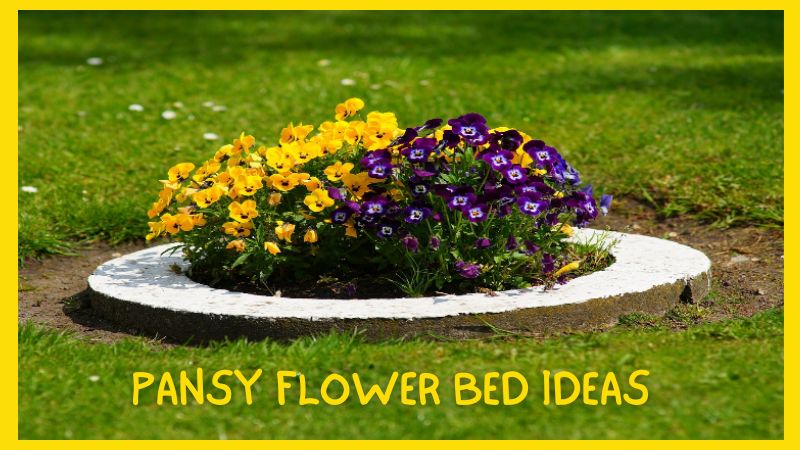GARDEN DECORATION
Pansy Flower Bed Ideas: Brighten Your Garden with Vibrant Blooms
Pansies are beloved for their vibrant colors, delicate petals, and striking patterns. These versatile flowers can transform any garden space with their cheerful appearance and resilience. Whether you’re an experienced gardener or a novice, incorporating pansies into your flower beds can add a splash of color and joy. This article Floral Garden Ideas will explore various pansy flower bed ideas to help you create a stunning and welcoming garden.
Understanding Pansies
Pansies (Viola x wittrockiana) are a popular choice for many gardeners due to their colorful blooms and ability to thrive in cool weather. They come in a wide array of colors, including purple, yellow, blue, white, and combinations thereof. Pansies are often planted in the fall for winter and spring displays in milder climates or in the early spring for a beautiful summer show in cooler regions.
Planning Your Pansy Flower Bed
Before diving into specific design ideas, it’s essential to consider a few planning aspects:
- Location: Pansies prefer full to partial sunlight. Ensure your flower bed gets at least six hours of sunlight daily.
- Soil: These flowers thrive in well-draining soil rich in organic matter. Amend your soil with compost if necessary to improve fertility and drainage.
- Watering: Pansies need regular watering, especially during dry periods. However, avoid waterlogging, which can lead to root rot.
Pansy Flower Bed Ideas
Color-Themed Beds
One of the most striking ways to use pansies is by creating color-themed beds. Choose a single color or a combination of complementary colors to make a bold statement. For example:
- Monochromatic Bed: Plant pansies of a single color, such as deep purple, for a sophisticated look. This approach works well in formal gardens or as a backdrop for more vibrant plantings.
- Complementary Colors: Pair colors that complement each other, such as yellow and purple or blue and orange. This contrast can create a visually stimulating and lively garden bed.
Seasonal Transitions
Pansies are ideal for transitional planting, bridging the gap between seasons. Use them to replace summer blooms that have faded or to introduce early spring color before other flowers bloom.
- Fall to Winter: Plant pansies in the fall to provide color through the winter and into early spring. Combine them with ornamental kale or cabbage for a winter display.
- Spring to Summer: Use pansies in early spring to fill beds before summer perennials take over. Pair them with bulbs like tulips or daffodils for a dynamic, evolving display.
Edging and Borders
Pansies make excellent edging plants due to their compact size and vibrant colors. Use them to outline flower beds, pathways, or garden borders.
- Formal Borders: Create neat, uniform borders with a single color or alternating colors for a classic, formal garden look.
- Mixed Borders: Combine pansies with other low-growing plants like alyssum, lobelia, or sweet peas to create a lush, colorful border.
Container Gardens
If space is limited or you want to add flexibility to your garden design, consider planting pansies in containers. This approach allows you to move plants around to optimize their exposure to sunlight and change your garden’s layout as desired.
- Hanging Baskets: Plant pansies in hanging baskets to add vertical interest to your garden. Mix different colors for a cascading effect.
- Window Boxes: Brighten windowsills with pansies planted in window boxes. Combine them with trailing ivy or small ferns for added texture.
Companion Planting

Pansies pair well with many other plants, both for aesthetic and practical purposes. Consider the following combinations:
- Bulbs: Plant pansies over bulbs like tulips, daffodils, or hyacinths. As the bulbs grow and bloom, they will create a layered effect with the pansies.
- Herbs: Combine pansies with herbs such as thyme, rosemary, or lavender. The contrasting foliage and textures enhance the visual appeal, and the herbs can benefit from the added ground cover.
Wildflower Meadow
For a more naturalistic look, integrate pansies into a wildflower meadow. Mix them with other annuals and perennials to create a tapestry of colors and textures that change throughout the season.
- Natural Groupings: Allow pansies to grow in clusters among other wildflowers. This approach mimics how flowers grow in the wild and creates a more relaxed, informal garden.
- Pollinator Friendly: Choose varieties and companion plants that attract pollinators like bees and butterflies, contributing to a healthy garden ecosystem.
Tips for Maintaining Pansy Flower Beds
- Deadheading: Regularly remove spent blooms to encourage continuous flowering and maintain the plant’s appearance.
- Fertilization: Feed pansies with a balanced, slow-release fertilizer at planting time and again mid-season to promote healthy growth and blooms.
- Pest Control: Monitor your wisteria for common pests such as aphids and slugs. Employ organic or chemical pest control methods as necessary to safeguard your plants.
Final Thoughts
Pansies offer endless possibilities for creating beautiful, vibrant flower beds. Whether you prefer a formal, color-coordinated garden or a natural, wildflower-inspired space, pansies can adapt to various design schemes. By carefully planning your flower bed, selecting complementary plants, and maintaining your garden, you can enjoy the cheerful and enduring beauty of pansies throughout the seasons. With their versatility and charm, pansies are sure to brighten any garden space, providing a visual feast for both gardeners and visitors alike.


